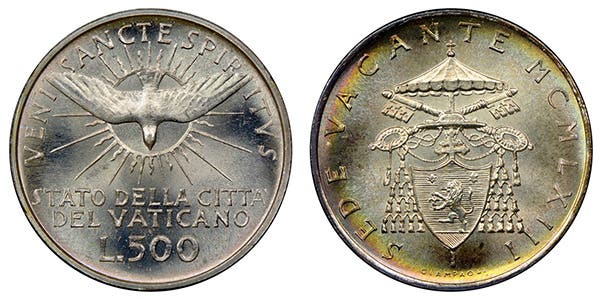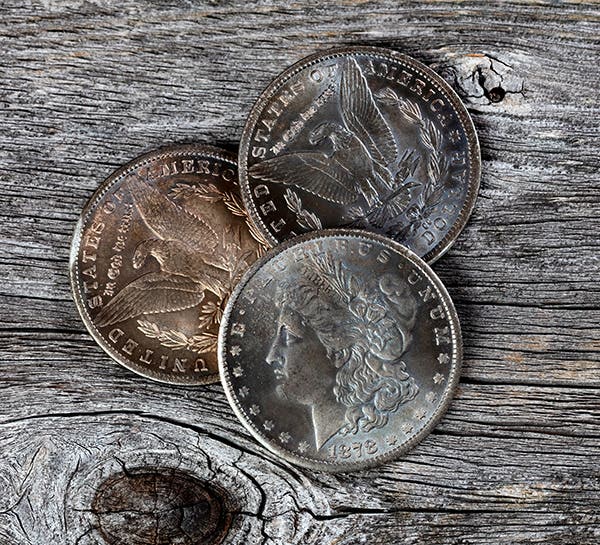The Strange Life of the United States Trade Dollar
Past Times with Coins looks at the extraordinary history of the U.S. silver trade dollar.
Recently, a writer in a different numismatic publication suggested that the U.S. Trade dollar (1873-1885), which was ostensibly issued for use in East Asia, didn’t enter circulation in the United States until after the 1878 Bland-Allison Act reinstated the 412.5-grain silver dollar as a full legal tender coin. This is incorrect. The coin, which at 420 grains was heavier than the 412.5-grain silver dollar it replaced with the passage of the Coinage Act of 1873, began circulating in the area of Nevada’s Comstock Lode shortly after its release in 1873. By 1876, the year it was demonetized, the Trade dollar had become a menace on the Pacific coast.
In the February 1965 issue of Coins magazine, Frances Williams Brown related the story of the Trade dollar in “That Was the Dollar that Isn’t.” At the time of Brown’s writing, the Trade dollar was still demonetized, and there was the belief that a new Peace dollar would soon enter circulation. The Trade dollar regained its monetary standard with the passage of the Coinage Act of 1965 on July 23, 1965. Though some were minted at Denver, the new Peace dollar never jingled in American pockets and purses.
“The Treasury’s announcement that this year the Mint will produce silver dollars for the first time since 1935 recalls one of the earlier incarnations of this stepchild of United States coinage,” Brown wrote. “Though seldom popular with Americans, the cumbersome ‘cartwheel’ inspired active hostility at only one epoch in its history. This was eighty or ninety years ago, during the brief lifetime of that unique piece, the trade dollar.
“The [word] ‘unique’ is not used here lightly, for the trade dollar has an unhappy distinction: it is the only kind of currency ever issued by the United States that the government will not redeem at its face value. Even the Civil War period’s fractional paper currency will bring from the Treasury every penny that it originally was supposed to be worth, but trade dollars are refused.
“Over 35 million of them were struck, and their silver content was higher than that of any other U.S. dollars ever made, yet a ‘New York Times’ editorial of June 1883 speaks of them scathingly as a ‘vicious form of currency,’ and as ‘nondescript and bastard coins which are no more legal tender than are the Japanese Yen.’ Why?
“Well, it might be blamed on the Chinese, or on the Comstock Lode, or on Mexico and Spain. For centuries Spanish money was regarded throughout the world as the prime standard of value, and gradually this aura of superiority spread to the products of the mints Spain had set up in Mexico. American traders, seeking business in China, were chagrined to have their coins scorned by China’s merchants, who would accept nothing but Spanish or Mexican dollars, which were slightly larger than ours….”
At the time, much of the Comstock was under the control of William C. Ralston and the Bank of California. As detailed in my 2001 book, Crime of 1873: The Comstock Connection, the paid relationship between Ralston and Dr. Henry R. Linderman, then a Treasury Department special agent, led to the inclusion of the Trade dollar into the Coinage Act. The Trade dollar, it was believed, would soak up some of the overflows of silver coming from domestic mining increases and a recent German demonization of the white metal. Its issue, it was argued, would help the bank and others with gaining a foothold in trade with East Asia.
“These ‘trade dollars’ were to be issued, on request only, to persons who provided silver bullion to pay for them,” Brown continued. “And since they were meant primarily for overseas trade, they were not to be legal tender in the United States in amounts of more than five dollars.
“In 1873, therefore, two different kinds of silver dollars were minted. The old-style piece had Liberty sitting in the same pose which had been hers since 1836; the heavier new-style dollar had her still seated, but turned in the opposite direction and looking a bit younger and less forbidding. And on the reverse, in addition to the familiar eagle, UNITED STATES O[F] AMERICA, and E PLURIBUS UNUM, were the words TRADE DOLLAR and 420 GRAINS—900 FINE, meaning that the coin weighed six one-hundredths of a pound (barely under an ounce) and it was nine-tenths pure silver.
“The first batches of trade dollars reached China at a time when a temporary shortage of the popular Mexican dollars (caused by a Mexican government upheaval) made Chinese merchants more favorably disposed than normally toward American money.
“With the new pieces, our traders were able to purchase the silks, brasses, teas, embroideries, and various other treasures of China that our great-grandfathers cherished. (A large proportion of the weighty coins, ironically enough, were promptly forwarded by the Chinese to India for the purchase of opium.)
“For the next several years, our Mint produced millions of the trade pieces annually for overseas use.
“On the homefront, however, after their initial interest as curiosities had passed, trade dollars were viewed with deep distaste. Hence, in 1876, Congress pronounced them no longer legal tender in the United States—not even within the five-dollar limit previously set.
“Even in the Orient, our trade coins soon began to feel the cold shoulder. Mexico’s mints had stepped up their production, and the Chinese were not interested in U.S. dollars when plenty of their beloved Mexican brand were available.
“In 1877, the bubble burst. That year, most of the Mint’s thirteen million new trade dollars were a drug on the market. Nobody wanted them. Something had to be done, and in 1878, it was done, but in a peculiar way. The Secretary of the Treasury ordered the making of trade dollars abandoned, but for five more years, the Mint kept striking large numbers of proofs, although the Treasury had posted notices in banks and post offices saying trade dollars must not be used as money.
“The Mint announced, moreover, that it would not redeem them – not even those made from 1873 to ’76, when they were still legal tender in limited amounts. Faced with such warnings, many businessmen either refused to take them or else accepted them at only 80 or 90 percent of their face value. ‘NO TRADE DOLLARS’ signs were common sites in shop windows.
“This kind of treatment aroused widespread popular indignation. How went the common complaint? Could anyone have faith in a government that would not honor or redeem the coins it had issued? Some unscrupulous employers managed to make a profit out of the situation by purchasing trade dollars at a discount and then using them at full valuation to pay foreign-born or illiterate workers who found it hard to understand what had happened when their wages turned sour.
“For nine years, the curious situation dragged on, with people who could get little or nothing for their trade dollars feeling more abused all the time. Then, in 1887 – eleven years after the coins had been officially banned as legal tender for domestic use – Congress, yielding to persistent complaints, ruled that trade dollars that had not been mutilated could be redeemed at their full face value if they were tuned in within six months.
“So that, at last, was the end of the trade dollar’s strange life as a United States coin. From the coin collector’s point of view, however, it was not the end. Nearly 36 million of the overweight pieces had been made, but during the period allowed for redemption, only about one-fifth of them were tuned in. The great majority either remained in China and other Far Eastern countries or else were melted down there for bullion.
“Some that were returned from China were refused for redemption because the U.S. Treasury said they were mutilated. This was quite true: they were mutilated. Chinese merchants had a habit of using steel dies to punch their own private ‘chop marks’ on coins’ surfaces as guarantees that they were genuine. By the time such money had passed through many hands and chopping, it was chewed up almost beyond recognition.
“But nowadays those chop-marked pieces on which the Treasury turned its back are the ones that many collectors value most highly. Compared to them, with their indelible souvenirs of an adventurous life, the promised ’64 cartwheels, shining and flawless of surface, are going to seem pretty innocuous.”
You may also like:








